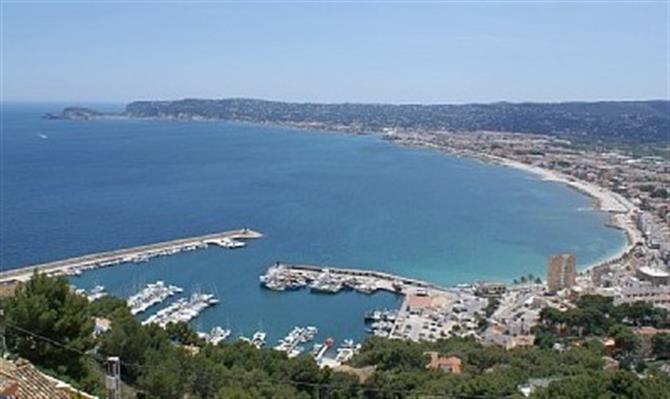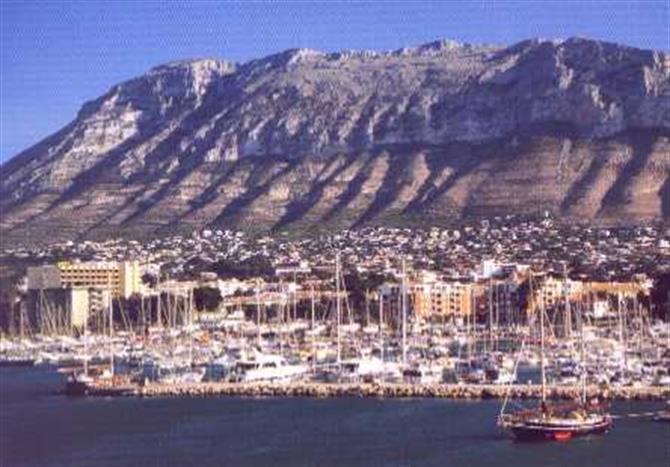Known as the elephant, the Montgo is an impressive mountain lying between Denia and Javea. Why the elephant? If you look at the incredible shape of the mountain, which seems to loom from the sea to caress the sky, you will see it looks like an elephant with its head and trunk clearly visible.
It’s a photographer’s dream as the rock formations change colour with the light and has inspired thousands of pictures and paintings particularly at sunrise or sunset.
The Montgo, at 735 metres at its peak, also provides a challenge for walkers, hikers and cyclists. There are various paths to take to explore the Montgo, some are easy and one is particularly tough, but all visitors will be rewarded with fabulous sea views. On a clear day, you can see as far as the Balearic island of Ibiza.
The mountain also provides a beautiful natural habitat for more than 650 plant species, including more than 80 which are very rare or in danger of extinction. The most emblematic is a native plant which grows exclusively on the Montgo and mountains in Ibiza and is called Carduncellus dianius.
The mountain also provides a playground for more than 150 wildlife species including the endangered Bonelli’s eagle, other birds of prey, snakes, lizards, badgers, dormice and rabbits.
Walking over the mountain from Denia to Javea
A favourite walk starts alongside the beautiful beaches of Las Rotas in Denia over to Javea Port.
It’s of medium difficulty but is 8.8kms one way and will take about three hours. You can catch the bus back from Javea to Denia or there is a boat sailing between the two resorts. You will need to check the frequency of the boat as it varies in summer and winter.
You can start from the Marineta Cassiana beach or save your legs by catching the bus from here to the end of Las Rotas. The walk is well worth it as it is alongside beautiful little beaches and bays in an area which many consider to be Denia’s finest.
Once you reach the end of Las Rotas, you will see the Torre del Gerro watchtower. From here, it is a climb where you can catch your breath to enjoy the views over Denia and up the Valencia coast as well as Javea bay.

The route then crosses through Las Planes and along to the steep cliffs at Cabo de San Antonio, which is a good place for a rest or picnic while looking over Javea to one side and Denia to the other. Dolphins are quite often seen swimming along here, so watch out for them too.
A large part of this area was destroyed by fire but new life is starting to spring back and the views are still spectacular.
Then it is a walk through scrubland, woods and old farms as well as the iconic windmills and down to Javea port with its picturesque yachts and fishing boats. There are many restaurants and bars here to stop for lunch or a snack before making the journey back.
Cyclists could return along the CV735 which lies at the foot of the Montgo, so there are glorious views of the mountain and countryside on both sides of the road going past Jesus Pobre and La Xara villages before returning to Denia.
Visiting the home of Pare Pere on the Montgo
An easier route up the Montgo is from the centre of Denia to visit the charming Pare Pere sanctuary. This is where the monk lived among beautiful natural surroundings where he prayed and meditated.
The walk starts from the large Plaza Jaume I square and along the Cami Pou de la Muntanya road up to the Ermita Pare Pere sanctuary, which is signposted. It is suitable for walkers and cyclists.
It will take about two hours by foot and 30 minutes by bike. It is a linear route but at least it is downhill on the way back.
It is a bit of an uphill walk for part of the 5.5km route but you can see the different flowers growing on the Montgo, particularly in spring, as well as views up the mountain and across Denia and its castle.
The route covers part of the Montgo which was previously cultivated by the farming community which grew figs, almond trees and carob trees.
Heading high up the Montgo to visit the cave
From the Pare Pere sanctuary there is also a 5.4km circular route, if you are feeling fit enough. This will take about three hours and is of moderate difficulty.
It is important to stick to the path to prevent damaging the precious plants along the route.
The walk takes us from the sanctuary up a few steep steps to the Cova de L’Aigua cave where you will see a Roman inscription at the entrance dated 238AD.
Ruins found in the cave suggest it was used in the Iberian Age and in the fourth or fifth centuries as a place of worship. It was also used as a water reservoir and can still flood with water after heavy downpours.
On the way back we continue on the same path for about 200 metres until we turn left towards the Raco del Bou which leads us to the Cami de la Colonia and back into Denia.
Montgo challenge for seasoned hikers
Another route from the Pare Pere sanctuary is very difficult and is a further 5kms one way. It should only be attempted by people who are used to mountain hiking and are wearing suitable shoes.
As before, head to the end of the Cami de la Colonia to the Raco del Bou (bull’s corner) and take the left path which is a steady climb up the Montgo. It is believed to have been named Raco del Bou because of the shape of the mountain in that area.
Towards the end of the walk, the path gets steeper as you climb higher.

At the plain there are various rock formations where you will see oaks, fan palms and rock roses growing among the boulders.
After a tough hike of 1,200 metres on the left there is a sign to the Creueta de Denia cross, which is another iconic landmark on the Montgo standing at 694 metres high.
The Cross was erected in 1999 with the help of a helicopter which brought it over from Denia and identifies the view of the Montgo from Denia.
The magnificent panoramic sea views become even more incredible the higher you climb, so it is worth persevering.
Tips for climbing the Montgo mountain
In the hot summer months, it is advisable not to walk in the mountain during the hottest part of the day. At all times, it is best to wear sensible shoes and hiking boots for the more difficult climbs.
There is little shade on the Montgo so there is no escape from the sun. Drink plenty of water, wear a hat and remember to cover up with sun cream.
Further information is available about the Montgo and the walks from Denia tourist information centre, Javea tourist information centre and the Montgo Interpretation Centre in Denia.
